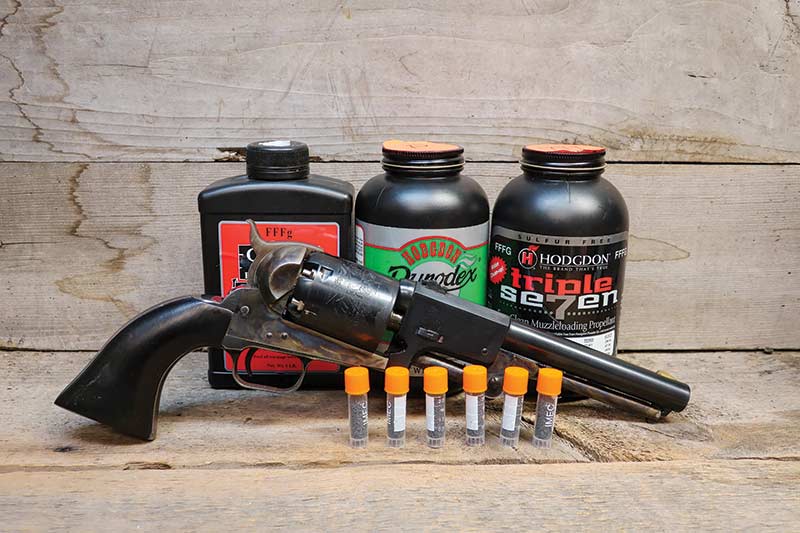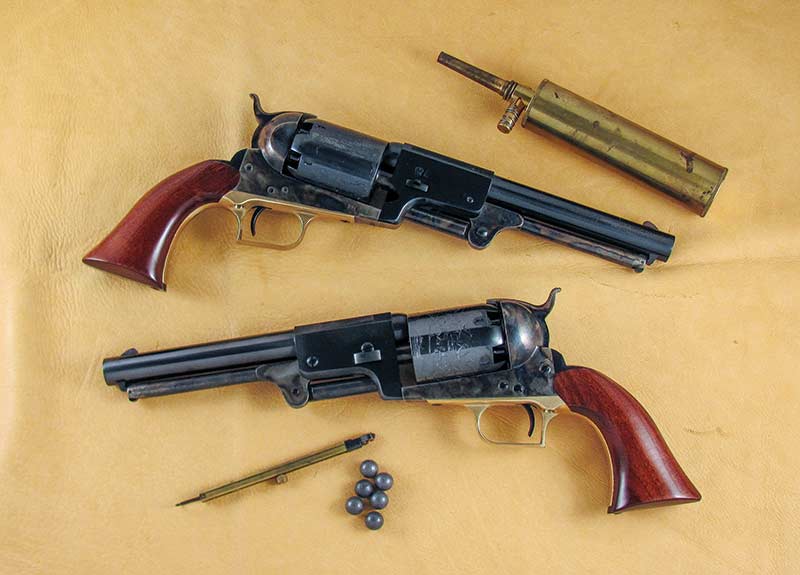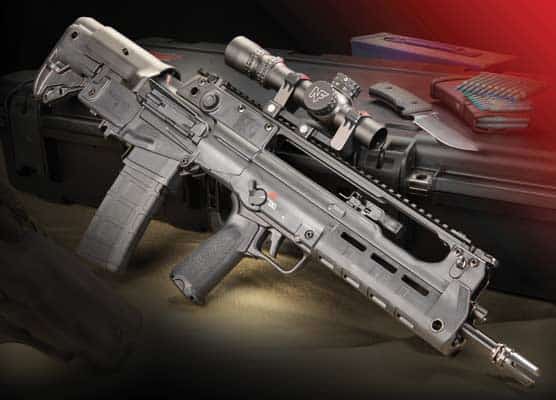Percussion Part 3
Dragoons With Round Balls
In late 1846, Texas Ranger Capt. Sam Walker put Colt back in business after their bankruptcy as he ordered 1,000 “heavy” revolvers complete with several improvements. By heavy, Sam Walker meant larger in caliber than the original Colt Paterson and definitely stronger. These were to be true sixguns, six-shot, 9″ barrels and in .44 caliber.
Horse Pistols
Walker himself held his Colts in high esteem saying they were good on man or beast out to 200 yards. However, the Walker Colt had two major drawbacks. These huge sixguns with 9″ barrels weighed 4 ½ lbs. and were very heavy and cumbersome sixguns. Walkers are not only so heavy they are very difficult to use, especially one-handed; a second problem is the loading lever often drops upon recoil. It did not take long for the Walker to be improved.
In 1848, the Transitional Whitneyville Walker Hartford Dragoon appeared. The grip frame, the mainframe, and working parts remained the same. However, the cylinder was shortened slightly and the barrel was cut back to 7 ½”. The locking arrangement of the loading lever was also changed, moving it from the center of the lever to the end with the spring-loaded male end matching up with the female stud on the barrel.
I find today’s replicas, both from Pietta and Uberti, are very well made as to fit and finish, authentically-styled and the cylinders lock up tightly. Over the past 30+ years, I have had extensive experience with Uberti Walkers. My last Walker purchase was the Transitional Walker Dragoon.
My standard loads are assembled with .454″ or .457″ Speer round balls and CCI #11 percussion caps. It averages just over 1″ for five shots at 20 yards using 30, 35, 40 and 45 grains of Hodgdon’s Pyrodex P, which is comparable to FFFg black powder. All measurements are by volume using a black powder measure. With 45 grains, muzzle velocity is well over 1,050 fps. With Goex FFFg black powder used in the Walker, 50 grains clock out at 1,160 fps.
Dial it back
Colt shortened the cylinder and barrel on the Transitional Model to make it lighter and somewhat smaller, bringing it to about 4 lbs. But how powerful were the 9″ Walker Colts with their longer cylinders? Using a replica 1847 Walker with 0.454″ Speer round balls and CCI #11 Caps over 55 grains of Goex FFFg with a lubed Thompson Wad in between powder and ball results in a muzzle velocity of 1,224 fps and places five shots into 1 ¼” at 50 feet. This is one of the most accurate loads I have found in my Walkers. Going up to 60 grains, something I would not recommend for continuous everyday use, gives a muzzle velocity well over 1,300 fps.
Several changes were made in the Walker to transition to the Dragoons. The grip was also changed and now had the familiar 90-degree cut at the top of the grip frame found on virtually all single-action sixguns produced since 1848. The barrel length was shortened to 7 ½” just as found on the transition model, which was known as the Whitneyville Walker Dragoon. The cylinder was shortened to accept a lighter charge of black powder, and the weight was now slightly over 4 lbs. To keep things from getting too complicated as far as change of machinery goes, the original frame size was maintained so, with the shorter cylinder, there was more room between the front of the cylinder and the barrel assembly with the barrel extending backwards to meet the cylinder. These first Transitional Walker Dragoons maintained the standard Walker grip frame but it was soon time for more changes.
Still Changing
The First Model had a square back trigger guard, round cylinder-stop notches, no pins between the nipples on the back of the cylinder and there was no roller on the hammer where it contacted the mainspring. With the arrival of the Second Model Dragoon in 1849, the trigger guard had been changed to the now familiar round shape. However, some were also made with the squared backed trigger guard. Cylinder stop notches also gained the familiar and traditional rectangular shape, a roller was placed on the hammer to contact the mainspring, allowing it to slide easily as the hammer was cocked, and pins were placed on the back of the cylinder between the nipples. These pins matched up with a hole in the hammer to allow the carrying of the Dragoon with all six chambers loaded without having to let the hammer down on a percussion cap.
The Third Model Dragoons all have round trigger guards. Dragoons would be produced slightly over 10 years or until 1860 when the last improved .44 percussion Colt revolver arrived.
Range Time
Using the Uberti 1851 Third Model Dragoon with 0.454″ Speer round balls and CCI Speer #11 caps, my best results have been obtained by pushing the Dragoon a little using 50 grains instead of 40 grains of powder. With 50 grains of Goex FFFg and Crisco placed over the seated ball to fill out the cylinder, muzzle velocity is right at 990 fps with five shots grouping into 1 ¼” at 50 feet. Switching to Pyrodex P using the same charge and lubing with Crisco, muzzle velocity is 955 fps with five shots grouping into 1 ⅜” at 50 feet. So basically the results are the same with black powder or Pyrodex. Charges below 50 grains resulted in groups in the 2 ½” to 3″ neighborhood.
For the 1st Model Dragoon, I used charges of 30, 35, 40 and 45 grains of Pyrodex P from Hodgdon’s as well as 35 and 40 grains of Goex FFFg. Groups averaged just barely over 1″ for five shots at 20 yards with the 45-grain charge of Pyrodex averaging right at 1,050 fps. All these were assembled by volume, not by weight, with 0.454″ round balls and #11 CCI Magnum percussion caps. With 45 grains of FFFg black powder using the same size round balls, muzzle velocities run just under 1,000 fps. Just as with people, all sixguns have their own personality.
Both the Walker and various Dragoons were all more than a little heavy for fast work from holster in the hands of any mere mortal. Although the 1851 Model Colt Navy .36 was much easier to handle, and certainly easier to pack all day in a holster than the Dragoons, it was also an exceptionally large step backwards as far as power goes.
How powerful were the Dragoons? We can get some idea by looking at a few figures. The .45 ACP with a 230-grain bullet at 825 fps figures out to a muzzle energy of 345 foot-pounds. With the Dragoon, using a 140-grain round ball at 990 fps results in 295 foot-pounds while the Walker with a maximum load giving 1,300 fps with a 140 round ball is at 525 foot-pounds. That is a lot of power plus the soft lead round ball also adds to its effectiveness. Those sixgunners during the Dragoon-era were definitely not undergunned.







